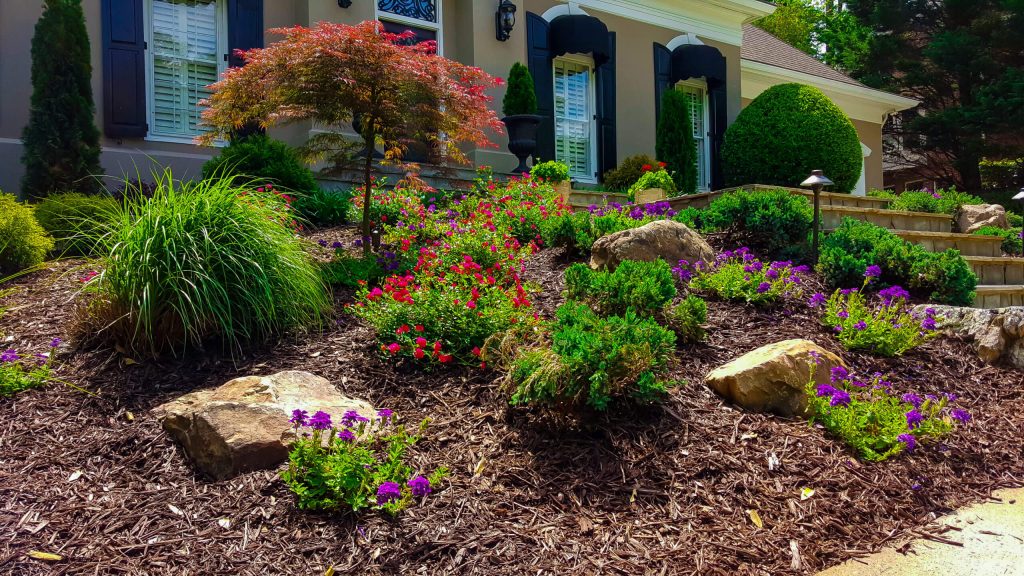Nothing can be more frustrating for a gardener than to spend time deciding what plants to grow, travel to the landscape garden center to select and purchase the plants, take them home and plant them only to have the plants either fail to perform as expected or worse yet, to die. New plant care differs from established plant care. Just a few extra minutes of your time can make all the difference in caring for new landscape plants.
New Landscape Plant Care
Plants grow in nature without all sorts of extra attention. Why can’t I rely on nature to take care of the plants in my landscape?
Ideally, nature would take care of this beautiful natural scenery for us. Unfortunately, we often want to grow plants in places they wouldn’t naturally grow. We also want to grow more of them than would naturally grow in an area. And we want to plant them at what nature would consider being the “wrong” time of season. Because of all this, we can’t rely on nature to provide the necessary elements to establish our new plants.
What should be considered a “new” plant?
“New” will vary according to the type and size of plants. Generally, our goal is to be sure any plant is getting what it needs. This is until it has developed a new root system along with enough foliage to gather what it needs from its surroundings.
How long do new plants need special care?
With fast growing plants such as annual flowers and vegetables, new plants will only need extra attention the first two or three weeks. Because they are genetically programmed to complete their life cycle within a growing season, they very quickly develop the needed roots and foliage. Perennials are a little slower to establish and may require special attention for a month or two. Woody plants, such as trees and shrubs, are much slower growing and are usually larger to start with. These plants will require extra attention throughout their first growing season. If woody plants are planted late in the season, they may need some help early the next season too.
If you are planting very large plants of any type, they will need even more care because they have much more plant material to support right away. Bulbs are the exception. Because they have their own fleshy storage system (i.e. a bulb, corm, rhizome, etc.), they are a little bit more tolerant of adverse conditions.
At the end of that period of time, can I just let the plants rely on nature?
Yes and no. After a period of time when you have babied them, plants will develop extra strength by going through slight periods of drought or other stress. But you certainly don’t want to push them too far. In the wild, it isn’t too crucial if a few trees out of a hundred die from some stress. But losing just one tree can be very important to the home landscape!
What are the basic needs of new plants?
A plant’s needs can be divided into two categories: what plants need before planting and what they need after planting. Before a plant is introduced, you need to determine if the site is right. Does it provide the level of light this specific plant will need to thrive? Could the soil type compatible with this plant? Is the pH of the soil acceptable? Is there good air circulation? Once you have matched the plant to the site or made any necessary adjustments to the site, the plant will require water and nutrition.
What is the most critical period of time for new plants?
Of course, the most critical period is going to be right after planting. Again, this critical time will vary according to the type of plant. You are moving a plant from one environment into another. It will help to take a few moments and note just how much of a change might be taking place. The plant may be going from a sheltered area where it consistently hydrated, to an exposed spot in your yard. The more drastic the change, the more careful you will need to be. During and immediately after the move, you will need to watch for signs of water stress. Newly planted plants may also develop signs of sunburn or windburn.
If the plant is being moved into a drastically different environment, is there anything I can do to help before planting?
Yes. If you have time, introduce the plant to its new environment gradually. A plant coming straight out of a warm greenhouse will require a few days in a cooler area before planting. If it is going from shade to sun, let it spend a few days where it will get lots of sun, but be shaded from the more intense direct afternoon sun. Letting a plant acclimate to new surroundings gradually makes your job easier in the long run.
Is there a single element that is the most crucial for new plants?
Absolutely. And that is water. All plants need water. Plants gather water principally by absorbing it with their roots from the soil. While a new plant has limited roots reaching into the surrounding soil, it is important to keep that area consistently moist, but not wet. How much water needed depends on a few things. These can be soil type, ground temperature, air temperature, wind, and the type of plant. Because so many factors can influence the amount or frequency of watering, there is no magic formula. You will have to judge your own situation.
How will I know if I am giving the new plants what they need?
The most common and obvious sign of trouble with a plant is wilting. The confusing part is that while plants most often wilt from lack of water, they can also wilt from too much water. Check the soil by digging down a few inches and feeling it before adding water. If it is still moist, lack of water is not the problem. Watering when plants have wilted from lack of water is easy. Drying out a plant that is too wet is difficult, especially since we don’t have control of the rain.
When will I need to feed the new plant, and with what?
Plants should be allowed to rely on the nutrients already in the soil when they are first planted. The general rule is related to the guideline you use for providing extra care. Annual flowers and vegetables can be fertilized after the first two or three weeks. Perennials can be fed after the first month or two. And woodies can be fertilized after their first season. Of course, all the basic rules for when to fertilize and what formulas to use should be followed.
What about products such as Start-Up?
There are some other very gentle starter solutions to help give your plants a jump-start. They are nutritionally very dilute and often contain a rooting hormone such as IBA (indole butyric acid). Such solutions might also contain some vitamins that can help your new plants.
Are there any plants that need less care?
There are plants that are considered low maintenance, easy-to-grow or drought tolerant. But even they need some extra attention to get established. Once they have settled in, they can need much less ongoing care, but not at first. You can make your job easier by working with nature. Avoid planting during the warmer, drier parts of the season and try to match the plant to the site. For instance, if you don’t have time to baby plants, avoid planting something that needs constantly moist shade in a sunny, dry site.
How often should I prune my shrubs?
Please read Walter Reeves’ Shrub Pruning Calendar for more information. He provides detailed information on several different species of shrub.
Installing, designing, and caring for new landscape plants can be a daunting task. Outdoor Makeover & Living Spaces is here to help! Contact our landscape design team to find out how we can create a new landscape for you.


 Screened-in Porch Benefits for Outdoor Living Experience
Screened-in Porch Benefits for Outdoor Living Experience Landscape Preparation For Spring
Landscape Preparation For Spring Preparing for Winter: 10 Tips for Winterizing Your Landscape
Preparing for Winter: 10 Tips for Winterizing Your Landscape
LET'S BE SOCIAL: